In 13 June 1980, the Prime Minister has approved the decision to establish the National Institute of Nutrition (NIN) belonging to the Ministry of Health. This event has marked an important milestone of the nutritional sector in our country, responded to urgent issues on nutrition and food safety in our country during post-war stage. This was suitable to international and regional situation that in each country, there is an Institute of Nutrition (also called Institute of Nutrition and Food Hygiene) as a Scientific Research and Consultative agency to Government on this issue.
Professor Tu Giay is the first biggest contributor to establishment and development of the Institute. With responsibility of Chairman of the National program on improved diet, he has proved in the model of Thai Nguyen metal industry area the possibility of improving diet and nutritional status of the workers. At that moment, several ministries such as Ministry of Agriculture, Ministry of Internal Commerce and Ministry of Food Industry have participated in this program. Since then, the state has been following the approach that requires an inter-sectoral cooperation with specific nutritional targets for each stage in order to improve nutritional status and diet. In the beginning, the material and personal situation of the Institute was still poor. At that stage, because there was no working place, the Ministry of Health could only arranged a room at 48 Tang Bat Ho street (in negotiation with the Medical College) as a meeting point. There was a big effort to attract nutrition and food staff from the Institute of Hygiene and Epidemiology, The Institute of Army logistics, Hanoi Medical College and other institutions to the Institute. The first staff group of the Institute consisted only six persons.
In the beginning of August 1981, the Food Hygiene section from Institute of Hygiene and Epidemiology have transferred to NIN as a part of the Institute, 30 staff and equipment of the Food Chemistry, Food Microbiology and Food Toxicology laboratories have moved to the Institute from the Institute of Hygiene and Epidemiology.
From 1980 to 1990: During this decade, with very thin manpower and poor equipments, the Institute has followed the policy of development as well as implementation of necessary activities. The nutritional survey carried out in Nong Cong district, Thanh Hoa province (1981) and in Binh Trung commune, Thu Duc district, Ho Chi Minh city (1982) have been followed by several nutritional surveys to identify the urgently nutritional issues at that moment.
| 
|
| | Prof. Tu Giay reported in the Workshop "Nutrition and health survey in Van thien commune, Nong Cong district, Thanh Hoa province, in 1981 |
The surveys showed that the diet of the people was quantitatively insufficient and qualitatively poor, malnutrition prevalence was high and the potential of improved diet at local level if garden, fish pond and husbandry would be properly developed. In 1981, the Nhan Dan (People) newspaper has published many articles written by Professor Tu Giay introducing Garden-Fish pond-Husbandry eco-system actually called VAC eco-system. An approach to improve diet has been introduced. At that time, with centralized agriculture cooperation policy, this approach facilitating usage of 5% of land to improve family food was supported by the farmers.
During the first 10 years, the Institute was the leading agency responsible for 2 National-level Scientific Research program coded 64-02 (1981-1985) and 64D (1986-1990). Several researches of that program have approached the timely and practical issues at that time as well as the present time such as:
- Epidemiology surveys of common nutritional deficiency disorders among women and children.
- VAC eco-system and diet improvement.
- Energy-saving stove.
- General survey on food consumption and nutritional status.
The community-based survey in large scale on Protein-Energy Malnutrition showed that in addition to severe forms like Kwashiorkor and Marasmus usually seen at Peadiatric department of the hospitals, the prevalence of moderate and mild forms among children is still high. Using the international classification recommended by the WHO, this prevalence is about 51.5 percent, even to more than 60 percent in some difficult rural areas. In addition to poverty, lack of knowledge on maternal care during pregnancy, breastfeeding and complementary feeding are the important causes.
| 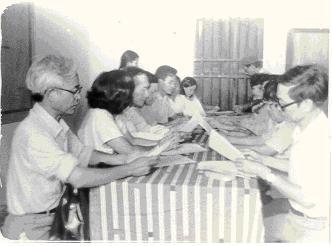
|
| | The examining board "The Healthy children feeding competition in Thanh Ha commune, Thanh mien district (6/9/19 |
During 1985-1988, with collaboration with the National Institute of Ophthalmology, a large epidemiological survey on xerophthalmia due to vitamin A deficiency was carried out in 27 provinces nationwide. The result of this survey showed that xerophthalmia due to vitamin A deficiency was still an important community health problem, prevalence of corneal lesions risky to blindness (X2/X3) was 0.07 percent, 7 folds higher than WHO cut-off-point considered as a public health problem needed to be solved. Xerophthalmia due to Vitamin A deficiency is related to feeding patterns, infectious diseases, in particular diarrhea, measles and respiratory infection.
Concerning food sciences, the Institute has implemented additional researches to complete the "Table of nutritional value of Vietnamese foods”, with attention on content of vitamins and minerals. Concerning food safety, there were several researches on artificial sugar, artificial coloring adding to foods, situation of some Aflatoxin toxic foods.
Concerning dietherapy, some pathological feeding regimes such as soybean-based yogurt for patients with digestive disorders, potassium-rich diet and low sodium for patients with hypertension.
It is noted that the researches, when completed have been put in suitable address for application such as VAC-ecosystem, breastfeeding, epidemiology of xerophthalmia and vitamin A deficiency in Vietnam.
| 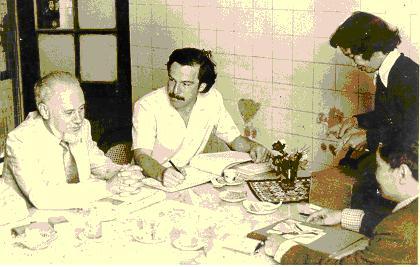
|
| | Prof. Ha Huy Khoi, vice director and Mrs. Le Bich Chau, chief of Planning department contacted with representative of UNICEF Hanoi, in 198 |
In some beginning years with plenty of difficulty, the Institute has given priority to international cooperation activities. The first international organizations having cooperation with the Institute are UNICEF and WFP.
Data from the surveys carried out by the Institute in some first years and the other surveys has been the basic document to defend the Project “Complementary feeding for high-risk subjects: mothers and malnourished infants” named PAM-2651 at total budget of US$ 24 millions. That was the first big internationally supported project from WFP when our country was isolated due to embargo. This WFP-supported project that was implemented in 8 provinces where there were several regions suffering from food shortage was the first nutritional activities with active public health significance when our country had to import rice and the prevalence of malnutrition was very high. With support from UNICEF, some household food security activities (such as VAC projects) and nutritional surveillance have been established. Two training courses on nutritional surveillance (in Hanoi, 1982 and Ho Chi Minh city, 1983) were the first step for development of nutritional surveillance system.
| 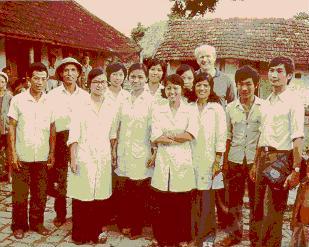
|
| | The nutritional survey team in Hoang long district, Ninh binh province (The man standing behind: Prof. J. Haurvast, a Dutch professor of nutrition) |
In order to control malnutrition, the Institute has particularly paid attention on breastfeeding. The workshop on breastfeeding held in 1983 and several follow-up activities have led to the Government’s decision on prolongation of maternal leaves from 2 months to 6 months, started since Jan. 1985.
The International conference on applied nutrition (April 1986) with participation of several Asian, African, European and Latin American participants has made the Institute of Nutrition of Vietnam to be well known with active first steps.
| | 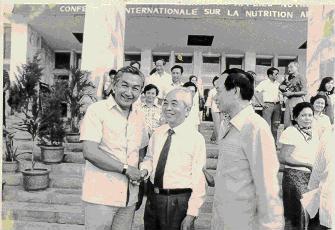
|
| | General Vo Nguyen Giap shook hands with Prof. D. Karyadi (Indonesia) in the International conference on applied nutrition in Hanoi (4/1986) |
During this decade, material of the Institute was improved. The Institute has gained some more budgets to upgrade the building at 48 Tang Bat Ho street. The new building was started to be built in 19 May 1989. Actually, working place consists of more than 100 rooms in 3 buildings and laboratory equipments have been gradually upgraded. The Direction board has usually paid attention on material and spirit life of staff. During 1983-1985, the Institute has received a project that upgraded food hygiene laboratory from WHO. These were the first precious machines that the Institute got. The Institute has also paid attention on establishment of nutrition and food hygiene network at Provincial Preventive Medicine Centers and at Nutrition department of Provincial hospitals.
The first decade 1980-1990 is characterized as opening period and confirmed the Institute’s continuous effort for existing and development.
From 1990 to 2000: The last years of the decade of 80 has marked several big changes in the world as well as in our country. Renovating policy (Doi Moi) of the 4th Congress of Party has made positive changes in social-economical situation of our country. Vietnam, from a rice importing country has become a rice self-sufficient and now even rice exporting country.
It was noted that during whole decade of 80, the Institute’s staff were almost not systematically trained except some short-term courses supported by UNICEF and NUFFIC (Netherlands). In this situation, the Institute requested the Ministry of Health to cooperate with Hanoi Medical College organized the 1st degree course on nutrition and food hygiene for our staff. In 1990, the Nutrition and Food Safety section was established within the Public Health department in Hanoi Medical College.
During this decade, the Institute has expanded its activities in the following main fields:
Scientific research: The Institute has carefully studied nutritional status of different subjects, in particular solutions for controlling malnutrition among children and micronutrient deficiency. The researches on effects of complementary foods with soybean protein and oil to infant growth; on nutrition formulae with digestive enzyme rich sprout powder to treat malnourished children were implemented. Concerning micronutrient deficiencies, there were the researches on relationship between vitamin A deficiency and nutritional anemia, iron reservation in high risk subjects, vitamin A concentration in serum and in breast milk. In 1995, with cooperation with UNICEF and CDC (Atlanta, USA), the Institute has carried out a National survey on iron deficiency anemia. The result showed that prevalence of nutritional anemia among mothers and children was still high, 53 percent among pregnant women, 60 percent among children under 2 years old. In addition to feeding regime, hookworm infection was an important cause for iron deficiency anemia.
The researches on foods has carefully done on analysis of b-carotene and iron in Vietnamese foodstuffs in order to serve the programs for control of micronuttrient deficiency. The upgraded food chemical and hygiene laboratories have allowed us to analyze situation of food contamination in more details and resolving solutions.
Concerning aspect of dietherapy, daily salt consumption in different ecological areas and its relation with hypertension and other diet regimes for some different pathological conditions have been studied.
From 1996 up to now, the Institute has been participating in the National Scientific and Technological program KH-11 titled “Studying strategic solutions for improving nutritional situation and food hygiene and safety”. This study was well accepted for the period 1996-1998 and actually was continuing in the period 1999-2000.
Based on the community surveys and international as well as national references, the Institute has developed “The Recommended dietary allowance requirement for Vietnamese” approved by the Ministry of Health and published in 1996.
The Institute has paid attention on nutritional issues in transition period in our country. Several researches have been carried out following that approach such as “Comparative study on trend of actual food consumption and nutritional status in the last decade”, “Monitoring of growth trend among children related with feeding patterns in some areas”, “Obesity and overweight situation among primary schooling children in Hanoi”…The researches on resolving the malnutrition in our country have been continued and improved. The Institute has especially paid attention on studies of community integrated model for development of feasible solutions to improve nutritional status of targeted population, in particular to control of malnutrition among children. The Institute has investigated and upgraded the food hygiene facilities at central and provincial levels.
Manpower development: Training for specialty upgrading has been facilitated in this decade. With support from SEAMEO-TROMED (Asean Tropical Medicine Organization), the first group of four staff (3 from the Institute, 1 from Hanoi Medical College) has been sent to attend a Master training course on community nutrition in Jakarta (1993). In November 1993, a seminar on community nutrition training was held in Hanoi. Since 1994, the Ministry of Education and Training has coded for master training on community nutrition at Hanoi Medical College and the Institute was appointed as a cooperative institution. From January 1995 to 1997, the Institute has implemented the project “Formation of nutrition cadres for implementation of the rural development program” supported by the French Government via FAO.
| 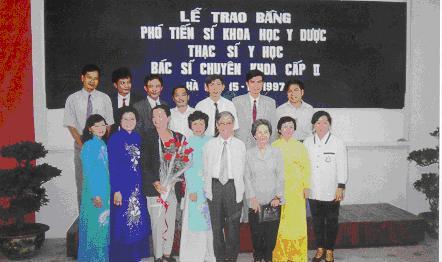
|
| | Masters on community nutrition (course I) graduation ceremony at the Hanoi medical college on 15/11/1997 |
The SEAMEO-TROMED continued to support the cooperative activities by provision of materials, training curriculum and abroad training for 7 staff at master level and 2 staff at Ph.D level.
The Institute has also established a collaboration with the Training Center on Planning nutrition in Los Banos, Philippines (RNP-FNP). Five staff trained in this center has complemented to the team of trainers and researchers for the Institute. In addition to the Master training courses in collaboration with Hanoi Medical College, there were many short courses on nutrition and food hygiene for lower level staff organized by Institute. Several young staff of the Institute have received the post graduate training in the Netherlands (ICFSN, Wageningen, the Netherlands), Belgium (ICFSN, Ghent and UniversitÐ Catholique Louvain, Brussels).
Thanks to effort in manpower development, staff structure at the Institute has greatly changed, some young staff has got Master degree and some got Ph.D level. We can say that the Institute has actively solved problem of lack of staff in coming period. Manpower development was a big effort of the Institute in the recent years, but diversification of speciality should be paid attention in coming years.
Implementing activities: The decade of 90s has marked a period of successful implementation of nutrition projects. The National Institute of Nutrition has introduced the Protein-Energy malnutrition among Vietnamese children and required a PEM control program. With active contribution of the National Institute of Nutrition, the Committee for Protection and Care of Children (CPCC) has developed and implemented this program from 1994 to 1997; that program has been shifted to the Ministry of Health since 1998 and since 1999, the Ministry of Health has appointed the National Institute of Nutrition as a leading institution for implementation. The Institute has quickly developed the Strategy of Action, development of Training curriculum and provided technical guidance to the implementing network at provinces. Through different periods, the Institute has remarkably contributed to the targets for PEM control among children. The PEM prevalence among children reduced from 45 percent in 1995 to 33.8 percent in 2000, average reduction rate was 2 percent per year, considered as high rate in the world.
During 1985-1986 period, several epidemiological surveys showed that prevalence of vitamin A deficiency causing irreversible blindness due to xerophthalmia was still high at significantly important public health problem. There was an agreement on importance of that problem at two seminars held in Hanoi (1986) and in Ho Chi Minh city (1987) and calling the Ministry of Health for intervention program. Since 1988, as policy of the Ministry of Health and with support from UNICEF and some other organizations, the vitamin A deficiency and xerophthalmia control program has been gradually expanded nationwide. Since 1993, the vitamin A supplementation days have been integrated with the national immunization days. Each year, millions children under 5 years old have received high dose vitamin A and high risk children being treated at hospital also received vitamin A as prescribed. An Information- Education -Communication (IEC) campaign on Micronutrient days (1st -2nd June) have been implemented in combination with promotion of VAC eco-system development in order to produce more micronutrient rich foods. In some districts, the specific propaganda was concretized such as papaya yellow, chicken egg red, sauropus green (in Thanh Mien district, Hai Duong province). Vitamin A and xerophthamia prevalence was remarkably reduced. In 1994, based the UNICEF-supported international survey, it was announced that Vietnam was xerophthalmia free. All objectives on vitamin A deficiency and xerophthalmia control were program achieved by the year 2000. It requires to sustainably reduce the moderate and mild forms of vitamin A deficiency influencing to health status, morbidity and mortality. During 12-17 February 2001, the 20th IVACG Meeting was held in Hanoi with participation of more than 700 participants from 73 countries, in which Vietnam has actively contributed to its success.
| 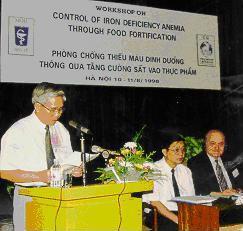
|
| | Prof. Do Nguyen Phuong, Minister of Health at the Workshop on Control of iron deficiency anemia through food fortification (Chairman: Prof Le Ngoc Trong, vice minister of Health and Dr. A Malaspina, the ILSI president) |
Since the end of the years of 80, the Institute has paid attention on nutritional anemia due to iron deficiency. An inter-institutional seminar on nutritional anemia was held at the end of 1989. The activities to control nutritional anemia in small scale were implemented on pregnant women in the WFP/3844 project areas with supplementation of iron/folic acid provided by UNICEF. The IEC activity on nutritional anemia in frame of appropriate nutrition IEC in general was prioritized. In 1995, another survey in large scale was carried out with cooperation of UNICEF and CDC (Atlanta). In comparison with vitamin A and Iodine deficiency, nutritional anemia control is more complicated and behind. Actually, in addition to daily iron/folic acid supplementation strategy, we have been exploring and assessing weekly iron supplementation and food fortification (iron fortification of fish sauce). The activities to control nutritional anemia will be strengthened in the next decade.
Concerning food and food safety science, the Institute has recently implemented several researches to update “the table of nutritive composition of Vietnamese foods”, to monitor and assess food contamination situation and the solution to solve as well as organized the annual training courses for provincial technicians.
| 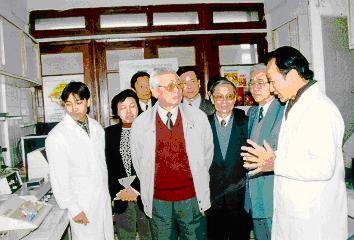
|
| | Prime Minister Vo Van Kiet visited Department of Food science and food safety on 09/12/1996 |
In December 1992, the International Conference on Nutrition held in Rome has called upon the States to develop and implement the National Plan of Actions on Nutrition. Our Government has responded to the above decision. After a preparatory period, in 16 September 1995, the Prime Minister has approved the National Plan of Actions on Nutrition (NPAN) 1995-2000.
That was an important milestone to mark the formation of nutrition policy in our country. The National Plan of Actions on Nutrition has put forwards the objectives of improving quantity as well as quality of diet, reduction of prevalence of malnutrition among women and children, reduction and ultimately elimination of micronutrient deficiency.
Seven sub-committees were established under the guidance of the Ministry of Planning and Investment. The Institute of Nutrition was appointed as focal point for nutrition and as an institution to assess the situation and prepare the annual plan. Despite of limited budget, some budget was reserved for implementation of the Micronutrient days (1st and 2nd June), organization of the nutrition and development week (16th to 23rd October), food hygiene and safety and nutritional surveillance activities at local levels. In the National Plan of Actions on Nutrition, the IEC activities were prioritized; instruction of appropriate diet, control of malnutrition and micronutrient deficiency, promotion of food hygiene and safety were disseminated through the mass media, the quarterly newsletter of Nutrition and Development was published and distributed down to community.
The main objectives of the National Plan of Actions on Nutrition were achieved. The general survey on food consumption and nutrition was carried out in 2000 to assess the progress, achievements, shortcomings and to prepare the plan for the next period. In 22 February 2001, the Prime Minister has approved the National Strategy on Nutrition for 2001-2010. This is a good opportunity to reinforce the nutrition activities in the next decade.
During 20 years of establishment and development, the Institute has implemented several international, national, ministerial and local researches. Hundreds of articles have been published in the international and national newsletter. Several books and seminar proceedings and other publications have been printed. The result of the researches has been applied in the implementing programs in large scale.
The Institute was offered the First Class Medal of Labor on the occasion of anniversary of 20th foundation day. Professor Tu Giay, the founding Director of the Institute was offered the title of Labor Hero.
The Institute has established a professional network that is still thin but available at all 61 provinces. The staff were most trained in short and special courses (food hygiene, community nutrition, curative diet) and some of them have got master degree on nutrition.
International cooperation: as soon established, the Institute has prioritize this activity. The Institute has cooperated with the international organizations like UNICEF, WFP, WHO and FAO since the beginning and based on this cooperative relation, several projects were implemented such as WFP 2651, vitamin A deficiency and xerophthalmia control, nutritional surveillance. In addition to these, the cooperation with many NGOs such as MCNV (Nertherland), OXFAM (Belgium) and LCMS (the USA) were expanded. Especially, the cooperative relation with the Institutes in the Region like Thailand, Indonesia, Philippines (Los Banos center) and several Universities like Wageningen Agriculture University (Human nutrition department), Netherlands, Center for Tropical Diseases, University of Oxford (UK), Nutrition department, Brookes University, Oxford (UK)… The cooperative relation with Institute of Nutrition of Japan and the Japanese Woman’s University has been expanded. A seminar on nutritional situation in Vietnam and in Japan was successfully organized in September 1997. The Institute has established the cooperative relation with the French Institute of Research and Development (IRD) and implemented the cooperative training, control of iron deficiency anemia, complementary feeding for children and nutritional surveillance. In December 1998, a Seminar on Inter-sectoral nutritional surveillance was successfully held in Hanoi with cooperation with the IRD (France) and the Institute of Tropical Medicine (IMT, Belgium). The cooperative relation with the International Life Science Institute (ILSI), Program Against Micronutrient Malnutrition (PAMM) has been developed. A Center for nutritional IEC was established with support from The Netherlands Royal Government.
20 years of the National institute of Nutrition achievement and perspectives